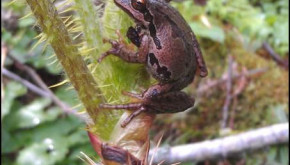
It’s that time of year again where we, like our animal counterparts, are apt to curl up into hibernation. Now that the holidays are over and the depths of winter have set in, it is far too easy to spend free time snuggled up inside with fuzzy slippers waiting for warmer weather. Even those of us who live and breathe the outdoors are having trouble finding an excuse to face the cold and wonder outside. However, some animals are just starting to become more visibly active in Western Washington. Mid-January is the start of amphibian (frogs, toads, and salamanders) breeding season! So, leave those fuzzy slippers by the door, put on a pair of mud boots or waders if you got ‘em, and go herping! Herping is hiking with the intention of finding amphibians and reptiles. Look below for easy tips to spot herps on your property.
“But, my property doesn’t have a wetland on it,” you say. Not a problem, you can still go herping. One of the biggest misconceptions about amphibians is that they are permanent residents of wetlands. While there are a few aquatic amphibians, most of our Western Washington amphibians depend on the combination of wetland and terrestrial (forests, meadows, etc.) habitat. There are even some salamanders that are completely terrestrial. So, you can still have the chance to find amphibians on your property.
Tip #1 Know the migration and breeding seasons
Mid-January to May is the best time for viewing adults. This is when our native amphibians are making their way to the wetlands. You can often find our amphibian adults migrating as well as in and around the edges of streams and ponds looking for mates. This is also the best time to find egg masses. Amphibians like water just above freezing to lay their eggs in. As the water warms the eggs begin to hatch in to tadpoles.
March through August is the best time to find tadpoles and juveniles. The tadpoles will forage and then metamorphose (develop into land dwelling juveniles) during this time and begin to explore outside of the wetlands as they begin to make their journey into their preferred terrestrial habitat.
Tip #2 Amphibians are most active on warm rainy nights
On warm rainy nights, there isn’t a chance of amphibians drying out, so they become more active and therefore are easier to spot. This is especially true during spring and fall. Start with searching trails, roads, and other openings for adult amphibians on their way to or from the breeding sites.
Tip #3 Play hide and seek
When amphibians aren’t breeding they use terrestrial habitats such as meadows, forests, and scrublands as places to forage, hide from predators, and keep cool and moist. While walking around on your property, look for the following habitat characteristics that will benefit amphibians:
• Turn over medium sized decaying wood where a salamander may take refuge and munch on insects.
• Inspect around rocks that can create shelter and maintain high relative humidity.
• Pull up piles of leaf litter, root balls, and moss-mats. Please remember to replace what you move back to its original spot so the beneficial habitat remains for all the wildlife living there.
Tip #4 Look in and around fresh water bodies for adults, juveniles, tadpoles, and eggs
Most Western Washington amphibians breed in either still water or streams. If you happen to be near a still water wetland, walk slowly around the edge paying special attention to the shallow water with emergent vegetation (plants with their roots in the water, but their tops extend above the water’s surface). You may see adults laying their eggs on the stems of these plants. This area is also where tadpoles look for food and take refuge from predators. Amphibians that have just finished metamorphosing will spend time in the moist soil and dense vegetation around the wetland buffer.
Stream breeding amphibians tend to prefer streams that are between one and three meters wide, rocky, and somewhat steep. Check the smaller pools that are created from slower moving water and turn over rocks within the pools and riffles. Streams are also common resting spots for amphibians on their migrations. They are a great place to stock up on moisture and find food.
Tip #5 Manage your property to attract amphibians with these easy suggestions from Living with Wildlife in the Pacific Northwest by Russell Link
• Maintain woodlands, wetlands, meadows, stream corridors, and shorelines
• Protect buffer areas next to streams, lakes, or ponds.
• Wherever possible, protect migration paths between uplands and breeding sites.
• Leave a portion of your grass unmowed,
• Preserve leaf litter under trees and shrubs.
• Retain stumps, logs, root wads, rock piles, and other debris that provides a cool, moist habitat for amphibians.
• Consider building a pond.
• Fence large ponds to prevent access by livestock.
• Avoid using pesticides and herbicides.
Tip #6 Stay safe
Wear the proper attire. Stay warm and wear mud boots or waders if walking around wetlands. Always bring someone with you. Wetland edges can be mucky and unstable. A friend can help you if your foot gets stuck in the muck.
It is not suggested that you handle the amphibians, but if you do please be very careful. Handling amphibians can be hazardous to their health and yours. Amphibians absorb things through their skin more easily than we do. Do not wear lotions, bug repellents, or other chemicals that can be harmful to amphibians if it is transferred to their skin.
Tip #7 Bring a field guide
Bringing a field guide will give you more tips on how find and Identify your new slimy friends. I suggest the Amphibians of the Pacific Northwest edited by Lawrence Jones, William Leonard, and Deanna Olson.
By Lauren Grand, Forestry Program Coordinator, Washington State University Extension

